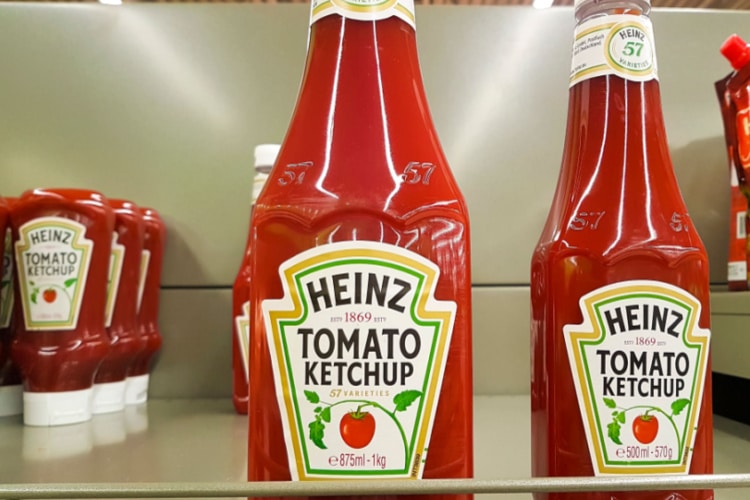Catsup for some, ketchup for others, but is there a distinction? Well, not really! Our favorite sweet sauce is known by both names.
There’s no difference between Ketchup and Catsup. Ketchup is the more popular and correct spelling of this condiment, while catsup was the first name to appear. Either way, both terms have existed in English for nearly 300 years.
Ketchup was initially called “catchup” but later separated into the two spellings we know today. The “tomato” component is also a recent addition. No pun intended, but for centuries, there was something fishy in the recipe.
Let’s travel back in time.
The Tomato Battle: Catsup vs Ketchup
The American Food and Drug Administration (FDA) recognizes three legal spellings for the substance — “catchup,” “catsup,” and “ketchup.”
The phrase “catsup” predates the one with a “k.” It was reportedly used in a passage by Jonathan Swift as early as 1730: “And, for our home-bred British cheer, Botago, catsup, and caveer.”
In 1876, however, the Heinz Company of Pittsburgh, Pennsylvania, began bottling and marketing its brand of tomato ketchup which they spelled with a “k.”
Other tomato condiment manufacturers termed their product “catsup,” but as Heinz developed and maintained ketchup market domination over the previous 140 years, competitors such as Del Monte and Hunt’s changed their spellings to “ketchup.”

The Verdict
There’s no distinction between ketchup and catsup. This is simply a form of generalization.
For example, regardless of brand, we refer to facial tissues as “Kleenex.” A machine that makes paper copies, whether produced by the Xerox company or otherwise, is referred to as a “xerox.”
The same goes with ketchup — it’s not a trademark but rather the spelling of the product’s dominant variant. So, if you ask us, it’s “ketchup” rather than “catsup.”
The “Fishy” History of Ketchup
This tangy-sweet sauce originated from a place and time you might not expect. The oldest known ketchup recipe is from 300 B.C. China. For thousands of years, it wasn’t even prepared with tomatoes – it was made with fish guts.
It is thought that the Chinese made a combination of pickled fish and spices and called it “ke-tsiap,” which translates to “pickled fish brine.” So yes, the original ketchup was nothing other than fermented fish paste.
But how did the rest of the world get its hands on it? Ketchup was most likely discovered by British settlers in Fiji or Indonesia. The sauce was appreciated for its ability to withstand long sea voyages.
Early British ketchup, however, was still nothing close to what we now pair with fries. When this sauce made it to Britain, they initially called it “catchup,” and it was any kind of sauce for flavoring and preserving. The most popular variations included mushrooms, fish, and walnuts.
Unsurprisingly, colonization brought the sauce’s ambiguous recipe to America. However, since tomatoes were considered poisonous (dubbed “poison apple”) in the 19th century due to their resemblance to deadly nightshade, they weren’t immediately included in the catchup recipe.
Nonetheless, in 1812, James Mease, a Philadelphia horticulturalist and chemist, incorporated tomatoes into the sauce’s combination. He released a recipe that marked the start of a new crimson age. That was the turning point in the evolution of these fruits from “poison apples” to “love apples.”
But that’s not all. In the late nineteenth century, the principle of preservation, along with the expansion of industrialization, resulted in a processed food boom. Between 1859 and 1899, total processed food output climbed by 1,500%.
These new processed goods were handy alternatives for food previously prepared from scratch. Additionally, huge food manufacturing businesses such as Pillsbury Quaker, Quaker Oats, Campbell Soup, and Heinz began standardizing products, recipes, and sauces.
In time, they created an industry of ready-made sauces, making and selling crowd-favorite sauces such as Worcestershire sauce, soy sauce, teriyaki sauce, and more.
The original ketchup we all celebrate today was invented by no other than Henry Heinz of the Heinz Food Processing Company. The firm was among the first to see the sauce’s potential, appeal, and the critical need for standardization.
Heinz reinvented ketchup by eliminating the potentially harmful preservation chemical “benzoate” and replaced it with more vinegar, ripe tomatoes, and sugar — thus creating the sweet and sour flavor we’ve all come to love.
Ketchup Was Once Used as Medicine
An Ohio physician, Dr. John Cook Bennett, wrote an article on the medicinal value of tomatoes, published in the newspapers in 1834. The article publicized tomatoes as a cure-all drug to treat all kinds of things, from indigestion and rheumatism to chlorella.
Regardless of whether it came as a sauce or a paste, people loved its benefits so much that it was even sold as pills, though in reality, very few contained any ketchup or tomatoes. However, the reputation of this medicine took a dive not long after, and Ketchup’s short-lived medical empire eventually collapsed.
Fun Facts About Heinz Ketchup
Did you know that you can speed up the ketchup pour by tapping the “57” on the neck of a Heinz bottle?
The number is completely made up; it’s a marketing trick developed by Heinz to attract more customers to the brand. Nevertheless, he stuck to it as he thought the number was lucky.
He was probably correct — today, ketchup is a $500 million industry, with Heinz selling more than 650 million bottles of ketchup in more than 140 countries worldwide, resulting in more than $1.5 billion in annual revenues.

Conclusion
The evolution of fish sauce into “catchup,” “catsup,” and eventually “ketchup” is an example of how one culinary item can spread and change through time and cultures.
There isn’t much of a distinction between catsup and ketchup. The term “ketchup” only appeared to gain in popularity. No matter the name, companies were careful to emphasize “tomato” on their labels to separate it from the fermented fish sauce of its early beginnings.






